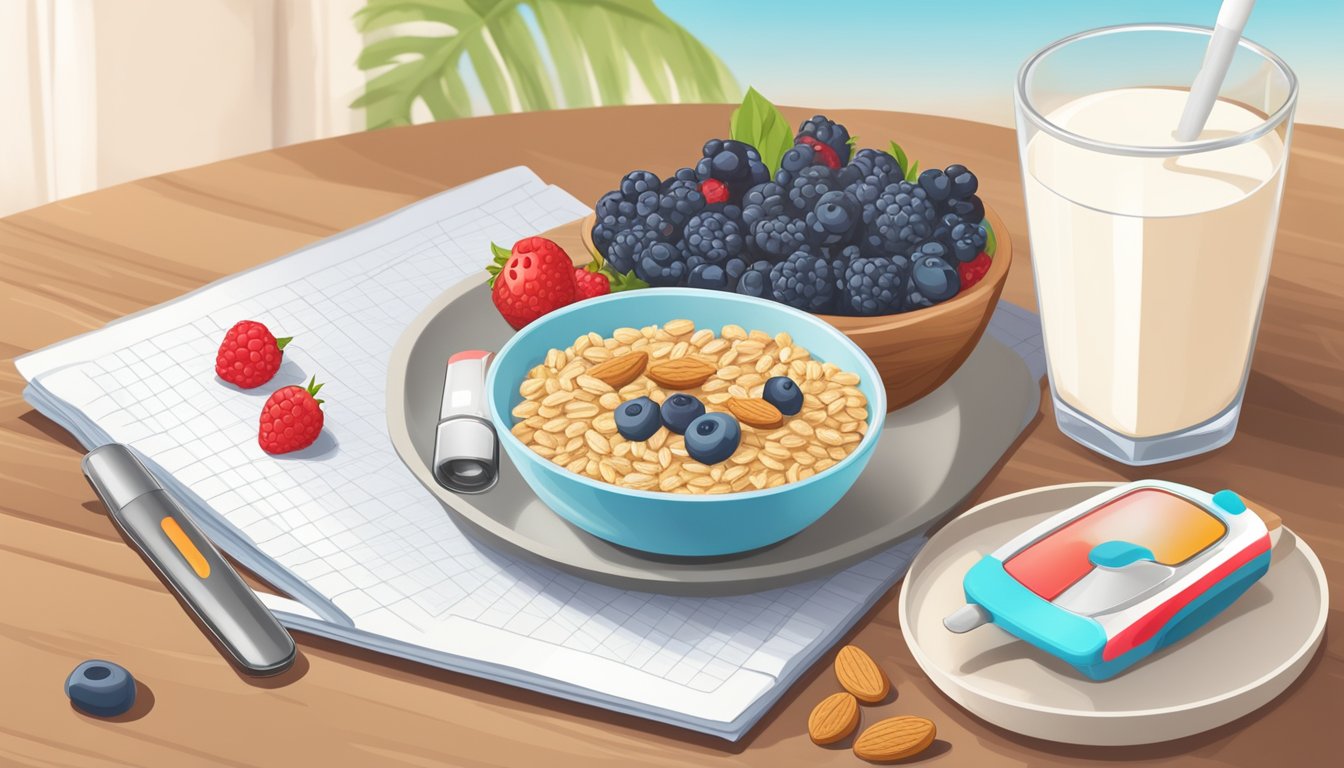Breakfast cereal is a quick and convenient option for many, but those with diabetes need to be mindful of their choices. The right cereal can provide essential nutrients while helping manage blood sugar levels. Whole grain cereals high in fiber and protein, with minimal added sugars, are the best options for people with diabetes.
Oatmeal stands out as an excellent choice for diabetics. It’s rich in soluble fiber, which slows digestion and helps stabilize blood glucose. Adding nuts or berries can further enhance its nutritional profile. Other good options include bran cereals and those made from whole grains like quinoa or barley.
When selecting a cereal, it’s crucial to check the nutrition label. Look for products with at least 3 grams of fiber per serving and less than 6 grams of sugar. Some brands offer cereals specifically formulated for blood sugar management. Portion control is also key – measuring out servings can help prevent overindulgence and maintain stable glucose levels.
Understanding Diabetes and Blood Sugar
Diabetes management centers on controlling blood sugar levels. The glycemic impact of foods plays a crucial role in maintaining stable glucose.
Role of Blood Sugar Control in Diabetes
Blood glucose regulation is vital for people with diabetes. High blood sugar can lead to complications like nerve damage, kidney problems, and cardiovascular issues. Monitoring glucose levels helps individuals make informed food choices and adjust medication if needed.
Insulin, a hormone produced by the pancreas, regulates blood sugar. In diabetes, the body either doesn’t produce enough insulin or can’t use it effectively. This results in elevated glucose levels.
Consistent blood sugar control reduces the risk of long-term health problems associated with diabetes. It also helps manage day-to-day symptoms and improves overall quality of life.
Glycemic Index and Glycemic Load Explained
The glycemic index (GI) measures how quickly foods raise blood sugar. It uses a scale of 0 to 100. Low GI foods (55 or less) cause a gradual rise in blood glucose. High GI foods (70 or above) lead to rapid spikes.
Glycemic load (GL) considers both the GI and the amount of carbohydrates in a serving. It provides a more accurate picture of a food’s impact on blood sugar. Foods with a low GL are generally better choices for people with diabetes.
Examples of low GI foods include:
- Most vegetables
- Whole grains
- Legumes
- Some fruits
High GI foods to limit include:
- White bread
- Sugary drinks
- Processed snacks
Choosing low GI and GL foods helps maintain stable blood glucose levels throughout the day.
Choosing the Right Breakfast Cereal
Selecting an appropriate breakfast cereal is crucial for diabetics to manage blood sugar levels effectively. The right choice considers whole grains, fiber content, hidden sugars, and proper portion sizes.
Whole Grains and Fiber Content
Whole grain cereals are excellent options for diabetics. They contain more fiber, which slows digestion and helps stabilize blood sugar levels. Look for cereals with “whole grain” as the first ingredient on the label.
Oat-based cereals are particularly beneficial due to their beta-glucan content. This soluble fiber supports stable blood sugar and lower insulin response.
Aim for cereals with at least 3 grams of fiber per serving. High-fiber options include:
- Oat bran cereal
- Wheat bran flakes
- Quinoa-based cereals
These choices provide sustained energy and help manage hunger throughout the morning.
Identifying Hidden Sugars
Carefully examine cereal labels for added sugars. Many seemingly healthy cereals contain high amounts of sugar, which can spike blood glucose levels.
Look for these terms indicating added sugars:
- Corn syrup
- Honey
- Dextrose
- Fructose
- Maltose
Choose cereals with 5% or less of the daily value for added sugars. Some brands offer no-added-sugar varieties, which are ideal for diabetics.
Be aware that fruit-flavored cereals often contain more sugar than their plain counterparts. Opt for unsweetened versions and add fresh fruit for natural sweetness.
Portion Size and Diabetes Management
Controlling portion sizes is essential for managing carbohydrate intake and blood sugar levels. Use a measuring cup to portion out cereal accurately.
A typical serving size is 1/2 to 3/4 cup of cereal. This amount usually contains:
- 15-30 grams of carbohydrates
- 100-200 calories
Pair cereal with protein sources like Greek yogurt or a hard-boiled egg to create a balanced meal. This combination helps slow digestion and provides longer-lasting satiety.
Consider adding nuts or seeds to increase protein and healthy fat content. These additions can help stabilize blood sugar levels and improve overall nutritional value.
The Best Cereals for Diabetics
Selecting the right cereal can help diabetics manage blood sugar levels while enjoying a nutritious breakfast. Ideal options are high in fiber and protein, low in added sugars, and made with whole grains.
Oatmeal and Its Benefits
Oatmeal is an excellent choice for diabetics. It’s high in soluble fiber, which slows digestion and helps stabilize blood sugar. Steel-cut or rolled oats are preferable to instant varieties, which may contain added sugars.
Oatmeal can be customized with healthy toppings like nuts, seeds, or berries to add flavor and nutrients. These additions provide protein and healthy fats, further improving the meal’s glycemic impact.
Studies have shown that regular oatmeal consumption can improve insulin sensitivity and help control blood sugar levels over time.
Bran-based Cereals
Bran cereals are rich in insoluble fiber, which aids digestion and can help manage blood sugar levels. Options like Kellogg’s All-Bran and bran flakes are good choices.
These cereals are typically low in sugar and high in nutrients like B vitamins and minerals. They can help create a feeling of fullness, potentially reducing overall calorie intake.
When choosing bran cereals, it’s important to check labels for added sugars. Some varieties may contain hidden sweeteners that can affect blood glucose levels.
Low-Glycemic Index Cereals
Low-glycemic index (GI) cereals are designed to have a minimal impact on blood sugar levels. Cereals like Grape-Nuts and some muesli blends fall into this category.
These cereals often contain a mix of whole grains, nuts, and seeds. The combination of complex carbohydrates, protein, and healthy fats helps slow digestion and glucose absorption.
Puffins Original and certain low-carb cereals can also be good options. They typically have fewer carbohydrates per serving, which can be beneficial for blood sugar management.
When selecting low-GI cereals, it’s crucial to pay attention to portion sizes. Even diabetes-friendly cereals can affect blood sugar if consumed in large quantities.
Cereals to Avoid

People with diabetes need to be cautious about their cereal choices. Some options can cause rapid blood sugar spikes and provide little nutritional value.
Cereals High in Added Sugars and Refined Grains
Cereals made primarily with refined grains and added sugars are poor choices for diabetics. These include popular varieties like frosted cornflakes, chocolate-flavored cereals, and those with marshmallows or candies. Such cereals often have a high glycemic index, causing quick blood sugar elevations.
Refined grains lack the fiber and nutrients found in whole grains. They’re quickly digested, leading to sharp glucose increases. Many sugary cereals contain over 10 grams of added sugar per serving, nearly half the daily recommended limit for adults.
Cornflakes, while often perceived as healthy, are made from refined corn and typically contain added sugars. They can raise blood glucose levels rapidly, making them a less-than-ideal option for diabetics.
Navigating Misleading Nutrition Labels
Cereal packaging can be deceptive. Terms like “whole grain” or “made with whole grains” don’t guarantee a healthy product. Manufacturers may add small amounts of whole grains to refined flour bases.
Check ingredient lists carefully. Whole grains should be first or second. Be wary of multiple sugar sources listed under different names like corn syrup, dextrose, or maltodextrin.
Pay attention to serving sizes. Many labels show unrealistically small portions, masking high sugar and calorie content. Use measuring cups to portion cereals accurately.
Look beyond claims of added vitamins and minerals like folic acid. These fortifications don’t offset high sugar or refined grain content. Focus on naturally nutrient-dense options instead.
Making a Healthier Breakfast Choice

Selecting the right breakfast cereal is crucial for diabetics, but enhancing the overall meal can provide additional health benefits. Adding nutrient-dense ingredients and choosing complementary foods wisely can create a more balanced and satisfying breakfast.
Incorporating Nuts and Seeds
Nuts and seeds are excellent additions to diabetic-friendly cereals. They provide healthy fats, protein, and fiber, which can help slow down digestion and stabilize blood sugar levels.
Almonds, walnuts, and pumpkin seeds are particularly beneficial options. These can be sprinkled on top of cereal or mixed into oatmeal. A tablespoon of chia seeds adds omega-3 fatty acids and extra fiber.
For those watching calorie intake, it’s important to measure portion sizes of nuts and seeds. A quarter cup is typically sufficient to reap the nutritional benefits without excess calories.
Choosing Accompanying Foods Wisely
Pairing cereal with the right foods can create a more balanced diabetic breakfast. Low-fat milk or unsweetened plant-based alternatives provide calcium and protein without added sugars.
Fresh berries or sliced apples offer natural sweetness and extra fiber. Greek yogurt can be a protein-rich topping that also adds creaminess.
For additional protein, consider adding a hard-boiled egg on the side. This helps increase satiety and provides essential nutrients.
Reading nutrition labels is crucial when selecting accompanying foods. Look for items low in added sugars and high in complex carbohydrates to support stable blood sugar levels.
Beyond Cereals

While cereals can be a good breakfast option for diabetics, there are many other nutritious choices to consider. Exploring alternatives and understanding how breakfast impacts blood sugar can help create a balanced morning routine.
Alternative Diabetic-Friendly Breakfast Options
Whole-grain toast with avocado or nut butter provides complex carbohydrates and healthy fats. Greek yogurt topped with berries and a sprinkle of nuts offers protein and fiber. Scrambled eggs with vegetables make a low-carb, protein-rich meal.
Cream of Wheat, fortified with vitamins and minerals, can be a warm alternative to cold cereals. For a savory option, try a vegetable omelet with a side of whole-grain toast.
Smoothies made with leafy greens, berries, and protein powder can be a quick, nutrient-dense choice. Chia seed pudding prepared the night before offers omega-3 fatty acids and fiber.
Understanding the Impact of Breakfast on Daily Blood Sugar
Eating breakfast helps regulate blood sugar levels throughout the day. A balanced morning meal can improve insulin sensitivity and reduce the risk of blood sugar spikes.
Protein-rich breakfasts tend to have a lower glycemic impact, helping to maintain steady blood sugar levels. Including healthy fats and fiber slows digestion, preventing rapid blood sugar rises.
Skipping breakfast may lead to overeating later and can make blood sugar control more challenging. Consistent meal timing, starting with breakfast, supports better overall glucose management.
Monitoring portion sizes and carbohydrate content at breakfast is crucial for maintaining healthy blood sugar levels. Pairing carbohydrates with protein and fat can help minimize blood sugar fluctuations.




